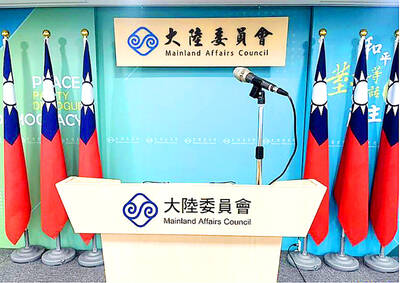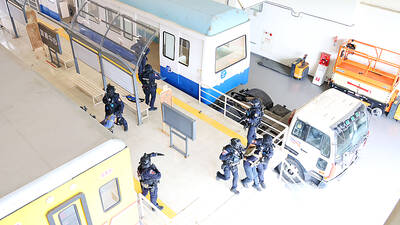At the end of their days, most people end up six feet under or up in flames; others get frozen or mummified.
But some lucky ones are spending eternity as sparkling diamonds, thanks to a peculiar chemical transformation.

PHOTO: AFP
For a fee, a company called Algordanza in the eastern Swiss canton of Graubuenden offers a service to turn ashes into precious stones.
Every month, it gets 40 to 50 commissions — some as far away as Japan.
One came from secretary Lilly Hess-Sollberger, who saw an article about the service and made her daughter Michele Galmarini-Hess promise to call Albordanza when she passed away.
She died three years ago at 82 and her ashes are now a half-carat blue diamond pendant that adorns her daughter’s neck.
“I wear it day and night, even when I go to bed. For me she’s alive, and it does me good,” said Galmarini-Hess, who lives in Montreux.
When asked about the diamond, she said some have shuddered but most people find it a “great” idea.
“You can’t imagine how many of them ask if they can kiss the stone,” she said.
Rinaldo Willy, 28, one of two co-founders of Algordanza, said the commissions come from “all kinds of people — they could be bus drivers or professors in philosophy.”
At the firm’s laboratory, about 15 machines run non-stop alongside employees wearing plastic protective glasses who work behind a yellow and black line that visitors are not allowed to cross — out of respect for the dead.
“Five hundred grams of ashes is enough to make a diamond, while a human body leaves behind on average 2.5 to 3 kilograms of ashes,” Willy said.
Potassium and calcium, which make up some 85 percent of the ashes, are first separated from the carbon.
The carbon is then subject to extremely high pressure and heat — 1,700˚C — a process which compresses it into graphite: a carbon allotrope, or a structurally different form of carbon. More pressure and heat are applied to the graphite to turn it into diamonds — the hardest allotrope of carbon.
The entire process takes six to eight weeks, hardly a fraction of the time it takes for the formation of natural diamonds, which takes thousands of years.
When the process is complete, the crude diamond still requires polishing and cutting. Many are cut into heart-shaped stones that can be worn as a pendant or mounted on a ring.
“Each diamond is unique — the color varies from dark blue to almost white,” Willy said. “It’s a reflection of the personality.”
Willy acknowledges that it is impossible to prove that each diamond is indeed made from a particular person’s ashes.
“DNA burns,” he explained.
But the “chemical imprint” of the ashes, determined at its arrival to the lab, allows for documentation to be made and for the finished product to be traced, he said.
The whole process costs between 4,500 Swiss Francs and 17,000 Swiss francs (US$4,400 and US$16,700), depending on the weight of the resulting stone (from 0.25 to one carat), and does not include the setting of the stone.
Algordanza, which means “remembrance” in Romansch, one of the four official languages in Switzerland, defends this as a reasonable price.
“A burial could be very expensive: It costs 12,000 euros [US$19,000] in Germany,” said Willy, who would not divulge his company’s revenues.
Not all agree with the process. Undertaker Yannick Abel-Coindoz at Geneva’s Murith funeral home said he had never received a request to make a “life gem,” as some call the stones, and has no plans to offer the service.
“It’s not in line with our ethics of burial and remembrance,” he said. “To wear your loved one as a ring and carry it with you everywhere prevents you from distancing yourself and thereby recovering from the loss.”
Yet the industry of “human diamonds” is booming, with similar companies in Russia, Spain, Ukraine and the US.
Founded in 2004, Algordanza has expanded to 20 countries, including six outside Europe, and employs about 100 people.
Willy said it is particularly popular in Japan, which sends between two to four urns daily, and the firm is setting its sights on China and India.
For Willy, a mobile world is fueling demand for such services. As people move farther from home, grave upkeep becomes difficult. And though cremation is increasingly popular, special permission is generally needed to transport urns across borders.
Though most life gem requests come from families after a loved one’s death, Willy said people are starting to ask for his firm’s services themselves in living wills before they die.
Individuals can even pay beforehand, with an insurance policy that covers their wish to become a diamond ... forever.

BUILDUP: US General Dan Caine said Chinese military maneuvers are not routine exercises, but instead are ‘rehearsals for a forced unification’ with Taiwan China poses an increasingly aggressive threat to the US and deterring Beijing is the Pentagon’s top regional priority amid its rapid military buildup and invasion drills near Taiwan, US Secretary of Defense Pete Hegseth said on Tuesday. “Our pacing threat is communist China,” Hegseth told the US House of Representatives Appropriations Subcommittee on Defense during an oversight hearing with US General Dan Caine, chairman of the Joint Chiefs of Staff. “Beijing is preparing for war in the Indo-Pacific as part of its broader strategy to dominate that region and then the world,” Hegseth said, adding that if it succeeds, it could derail

CHIP WAR: The new restrictions are expected to cut off China’s access to Taiwan’s technologies, materials and equipment essential to building AI semiconductors Taiwan has blacklisted Huawei Technologies Co (華為) and Semiconductor Manufacturing International Corp (SMIC, 中芯), dealing another major blow to the two companies spearheading China’s efforts to develop cutting-edge artificial intelligence (AI) chip technologies. The Ministry of Economic Affairs’ International Trade Administration has included Huawei, SMIC and several of their subsidiaries in an update of its so-called strategic high-tech commodities entity list, the latest version on its Web site showed on Saturday. It did not publicly announce the change. Other entities on the list include organizations such as the Taliban and al-Qaeda, as well as companies in China, Iran and elsewhere. Local companies need

CROSS-STRAIT: The MAC said it barred the Chinese officials from attending an event, because they failed to provide guarantees that Taiwan would be treated with respect The Mainland Affairs Council (MAC) on Friday night defended its decision to bar Chinese officials and tourism representatives from attending a tourism event in Taipei next month, citing the unsafe conditions for Taiwanese in China. The Taipei International Summer Travel Expo, organized by the Taiwan Tourism Exchange Association, is to run from July 18 to 21. China’s Taiwan Affairs Office spokeswoman Zhu Fenglian (朱鳳蓮) on Friday said that representatives from China’s travel industry were excluded from the expo. The Democratic Progressive Party government is obstructing cross-strait tourism exchange in a vain attempt to ignore the mainstream support for peaceful development

ELITE UNIT: President William Lai yesterday praised the National Police Agency’s Special Operations Group after watching it go through assault training and hostage rescue drills The US Navy regularly conducts global war games to develop deterrence strategies against a potential Chinese invasion of Taiwan, aimed at making the nation “a very difficult target to take,” US Acting Chief of Naval Operations James Kilby said on Wednesday. Testifying before the US House of Representatives Armed Services Committee, Kilby said the navy has studied the issue extensively, including routine simulations at the Naval War College. The navy is focused on five key areas: long-range strike capabilities; countering China’s command, control, communications, computers, cyber, intelligence, surveillance, reconnaissance and targeting; terminal ship defense; contested logistics; and nontraditional maritime denial tactics, Kilby